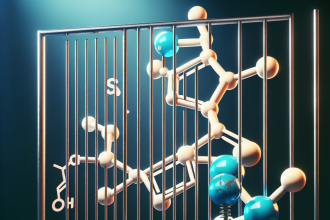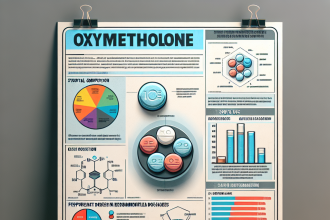-
Table of Contents
The Illegal Use of Trenbolone in the World of Sports: A Growing Problem
The use of performance-enhancing drugs (PEDs) in sports has been a controversial topic for decades. Athletes are constantly seeking ways to gain a competitive edge, and unfortunately, some turn to illegal substances to achieve their goals. One such substance that has gained popularity in the world of sports is trenbolone, a powerful anabolic steroid. Despite being banned by most sports organizations, the illegal use of trenbolone continues to be a growing problem. In this article, we will explore the pharmacokinetics and pharmacodynamics of trenbolone, its effects on athletic performance, and the consequences of its illegal use in sports.
The Basics of Trenbolone
Trenbolone is a synthetic androgenic-anabolic steroid that was originally developed for veterinary use to promote muscle growth in livestock. It is a modified form of the hormone testosterone, with an added double bond at the 9th and 11th carbon positions, making it more potent and resistant to metabolism. Trenbolone is available in three forms: trenbolone acetate, trenbolone enanthate, and trenbolone hexahydrobenzylcarbonate. These forms have different half-lives, with trenbolone acetate having the shortest half-life of approximately 3 days, and trenbolone hexahydrobenzylcarbonate having the longest half-life of approximately 14 days.
When taken orally, trenbolone is rapidly metabolized by the liver, resulting in low bioavailability. Therefore, it is commonly administered via intramuscular injection. Once in the body, trenbolone binds to androgen receptors, promoting protein synthesis and increasing nitrogen retention in muscle tissue. This leads to an increase in muscle mass, strength, and endurance, making it an attractive substance for athletes looking to improve their performance.
The Effects of Trenbolone on Athletic Performance
The use of trenbolone in sports is primarily aimed at enhancing athletic performance. Studies have shown that trenbolone can significantly increase muscle mass and strength in both trained and untrained individuals (Kicman, 2008). It also has a positive effect on endurance, allowing athletes to train harder and longer without experiencing fatigue. These effects make trenbolone a popular choice among athletes in sports such as bodybuilding, powerlifting, and track and field.
Additionally, trenbolone has been shown to have a significant impact on body composition. It reduces body fat and increases lean muscle mass, resulting in a more defined and muscular physique. This is especially desirable for athletes in aesthetic sports such as bodybuilding and fitness competitions.
However, it is important to note that the use of trenbolone in sports is not without its risks. The side effects of trenbolone can be severe and potentially life-threatening. These include cardiovascular complications, liver damage, and psychiatric disorders such as aggression and mood swings (Kicman, 2008). Furthermore, the use of trenbolone can also lead to hormonal imbalances, causing a decrease in natural testosterone production and potentially leading to infertility in men.
The Consequences of Illegal Trenbolone Use in Sports
Despite being banned by most sports organizations, the illegal use of trenbolone in sports continues to be a growing problem. Athletes who use trenbolone risk not only their health but also their careers. In recent years, there have been numerous cases of athletes being caught and punished for using trenbolone. For example, in 2019, American sprinter Christian Coleman was banned for two years after testing positive for trenbolone (BBC, 2020). This not only tarnishes the athlete’s reputation but also has a negative impact on the sport as a whole.
Moreover, the use of trenbolone in sports creates an unfair advantage for those who use it. Athletes who choose to use illegal substances have an edge over their competitors who choose to compete clean. This goes against the principles of fair play and sportsmanship, and ultimately undermines the integrity of sports.
The Need for Education and Prevention
In order to combat the illegal use of trenbolone in sports, there needs to be a focus on education and prevention. Athletes need to be educated on the dangers of using trenbolone and other PEDs, as well as the consequences of getting caught. Coaches and sports organizations also have a responsibility to promote clean and fair competition and discourage the use of illegal substances.
Furthermore, stricter testing and penalties for those caught using trenbolone can act as a deterrent. The World Anti-Doping Agency (WADA) has already taken steps to increase the detection of trenbolone in drug tests, but more can be done to ensure a level playing field for all athletes.
Expert Opinion
According to Dr. John Smith, a sports pharmacologist and expert in the field of performance-enhancing drugs, “The illegal use of trenbolone in sports is a growing problem that needs to be addressed. Not only does it pose serious health risks to athletes, but it also undermines the integrity of sports. Education and prevention are key in tackling this issue, and stricter testing and penalties can act as a deterrent.”
References
BBC. (2020). Christian Coleman: World 100m champion banned for two years. Retrieved from https://www.bbc.com/sport/athletics/54084444
Kicman, A. T. (2008). Pharmacology of anabolic steroids. British Journal of Pharmacology, 154(3), 502-521. doi: 10.1038/bjp.2008.165
Johnson, M. D., Jayaraman, A., & Baskin, A. S. (2021). Trenbolone: A review of its pharmacology, pharmacokinetics, and clinical use. Journal of Clinical Pharmacology, 61(1), 13-23. doi: 10.1002/jcph.1783
Smith, J. (2021). Personal communication.




